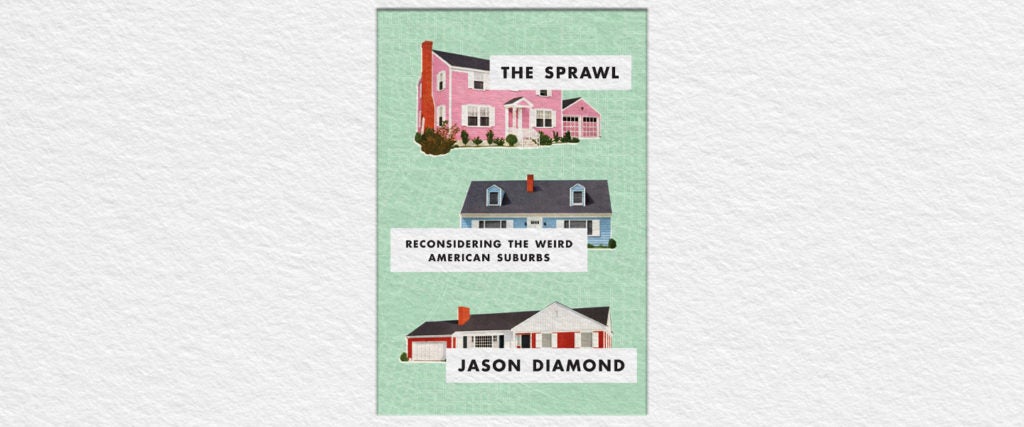In 1961, the historian and critic Lewis Mumford damned the suburbs with a description that’s defined them in the popular imagination ever since: “A multitude of uniform, undefinable houses, linked up inflexibly, at uniform distances, on uniform roads, in a treeless communal waste, inhabited by people of the same class, the same income, the same age group, witnessing the same television performances, eating the same tasteless pre-fabricated foods.”
When Mumford wrote these words, in his National Book Award-winning study, The City in History, the Levittown model of suburbia was ascendant in the U.S. Built by William J. Levitt, these pre-planned developments — the first appearing on Long Island in 1947, with others soon following in Pennsylvania and New Jersey — were the definition of suburban conformity. Constructed quickly to accommodate the growing housing need among World War II vets, these racially restrictive developments offered rows of cheaply built tract houses, each with its own lawn, white picket fence and share of up-to-moment appliances. Residents were barred from adding onto their houses and were strictly charged with the orderly upkeep of their property.
Notions of suburban conformity — and whiteness — are largely the product of Levitt’s circumscribed vision and are what so bothered Mumford. It was a pattern that would spread quickly throughout the country.
But, of course, it didn’t have to be that way. As Amanda Kolson Hurley details in her 2019 book Radical Suburbs: Experimental Living on the Fringes of the American City, ideas about suburban growth weren’t always so conformist-minded. English urban planner Ebenezer Howard, for example, had a far more progressive vision that he developed in the late 19th and early 20th century. The founder of the garden city movement, Howard aimed to build utopian communities on the outskirts of urban areas that served a positive social purpose. The garden city would be a mixed-income town, providing comfortable housing for working-class people and the middle and upper-middle classes alike. It would also be a self-contained walkable community and, owning the land it was built on, the town would use rents to fund public services. Howard built the first garden city, Letchworth, near London, in 1903, and his plan soon spread to the U.S. with towns like Greenbelt, Maryland, and Greenhills, Ohio sprouting up in the 1930s. It was a development that had Mumford optimistic — and helps explain his subsequent disillusion — but it was one that wasn’t to last. Facing financial restraints, many of these towns were forced to sell to private owners who were ideologically opposed to public housing and quickly set about eviscerating Howard’s vision. As Hurley puts it, when “Greenbelt passed out of federal hands, the vision of dignified, egalitarian public housing withered.”
Hurley’s book is an attempt to reclaim the progressive legacy of the suburbs by profiling six American communities that challenged the standard assumptions of suburbia — whether economically, architecturally or racially — and showing how these examples might yet be implemented. It’s one of several recent books to rethink what suburbia means, a literature now joined by Jason Diamond’s new book-length essay, The Sprawl: Reconsidering the Weird American Suburbs. Hurley’s and Diamond’s books are linked by an intensive interest in what the suburbs have historically been, how they do and don’t adhere to the standard narratives we tell about suburbia and what they may become in the future. Both are cautiously optimistic about that future and both understand the increasingly important role that the changing suburbs will play in the future of American lives, even as their methods and interpretations differ considerably.
Combining memoir and cultural criticism, The Sprawl unfolds as a series of chapters that each consider the suburban question from a different perspective. Diamond’s own viewpoint is that of a man who grew up in the ‘burbs in the 1980s and 1990s where he experienced his share of angst and alienation, who has lived in cities since his early 20s and who has complicated feelings about where he was raised. Growing up in a number of different Chicago-adjacent towns, the product of divorced parents who were mentally and physically abusive, Diamond had a largely unhappy childhood. As a “bored, anxious teenager,” he immersed himself in music, literature and pop culture, using one of the advantages he had as a suburban kid, “lots of space and plenty of free time to roam around it,” to explore these art forms and envision a future beyond where he lived.
Diamond readily acknowledges the diversity of people’s experiences in suburbia, noting that “the suburbs aren’t one thing or another” and acknowledging that they don’t always fit the standard descriptor of a “monolith of conformity and tract housing,” but his focus on his own experience frequently leads him to universalize his feelings about the suburbs, making of them a general condition. “[The] emotions engendered by living in the suburbs are consistent over time,” he writes, in one such statement, “anxiety, boredom and alienation.”
For Diamond, it is these qualities that constitute the suburban imagination and, manifested by musicians, writers and filmmakers who grew up outside of the city, define their aesthetic, one that tends to remain quintessentially suburban, no matter how long it’s been since they moved on from their hometowns. “As a structured and structuring way of being,” Diamond writes, “suburban sprawl foments a kind of imaginativeness in people that’s both unique to the boring suburban imagination and reflective of an alienating longing for the archetypal urban lifestyle.” This disaffected imaginativeness leads to a proliferation of a specific type of artwork, one that either takes suburban discontent as its subject or indirectly expresses the alienation fostered by suburbia. While Diamond acknowledges that not all art made by suburbanites fits the pattern, his definition of a disaffected suburban aesthetic is central to his view of suburbia, a way of harnessing the negative potential of suburban ennui and putting it to positive, if necessarily limited, use.
If suburbia is defined in the popular imagination by a few central narratives, then the standard American dream trajectory has largely given way to new, less flattering visions. As Hurley writes, in the 21st century, “pop suburbia is either a facade of upper-middle-class conformity about to crack and reveal its dark secrets… or a hellscape of dead malls and ‘zombie subdivisions,’” narratives that she finds both unproductive and largely inaccurate. Diamond, however, while acknowledging the limitations of these visions, bases much of his conception of the suburban aesthetic on the façade-about-to-crack model. And though the dark-flipside-of-suburban-utopia idea has provided a fertile supply of artistic inspiration, it’s also one that tends to quickly run up against certain limits of the imagination.
Throughout The Sprawl, Diamond traces the history of art that turns a jaundiced eye on suburbia, from books like the 1955 bestseller The Man in the Gray Flannel Suit and the stories of John Cheever, to films like Blue Velvet, to the work of suburban punk bands like The Descendents. He also identifies other suburban-raised artists, such as the writer Shirley Jackson, who without reflecting directly on the suburbs, channel their suburban upbringing to create their own portraits of discontent. “Whether it’s about rallying against conformity or people doing drugs to escape the banality of their everyday lives,” Diamond writes, “the suburbs make great fodder for a music” — and presumably other art forms — “that’s fueled by anger about the way the world works.”
This is undoubtedly true, but while it’s natural to see artists shaped by the places they grew up, it’s also a bit limiting to offer up a conception of art that’s so defined by a strict negativity, by what it measures itself against, rather than what it is in its own right. While Diamond offers exceptions, from Jonathan Richman’s optimistic ode to suburban driving, “Roadrunner,” to the inventors of techno music, the Belleville Three, to the atypical punks The Misfits, he mostly sees suburban art as being defined by a rejection of where the artist came from and an expression of the anger that their hometowns gave rise to.
If Diamond’s take on the suburban aesthetic seems a bit confined, though, his vision of what the suburbs might become is considerably larger, more consistent with Hurley’s open-minded conception. One of the places Diamond grew up, and his favorite, is Skokie, Illinois, a walkable multi-ethnic “village” of 65,000 people that borders Chicago. As Diamond puts it, “Skokie is what I love about America and what I’d love to see more of.” He finds a fulfillment of this desire for a more workable suburbia in places like Plaza Fiesta, a shopping plaza on the outskirts of Atlanta that serves as a gathering place for the local Latinx community, while Hurley documents such similarly gratifying institutions as The Block, an impromptu Asian food court in Annandale, Virginia, and the community-oriented Oak Park Housing Center in suburban Chicago.
As the suburbs become more diverse and more populous, as people unable to afford increasingly expensive cities opt for new ways of living, these towns, villages and small cities no longer fit the traditional narratives that defined them — if indeed they ever did. Less white, less culturally homogenous than in the past, they offer new ways of living, new solutions to the problem of organizing lives. There’s nothing that says the suburbs have to be alienating, that they must produce only a certain disaffected response, and in the future, if current trends continue, they may well just not.

